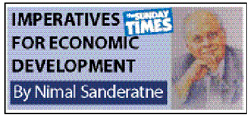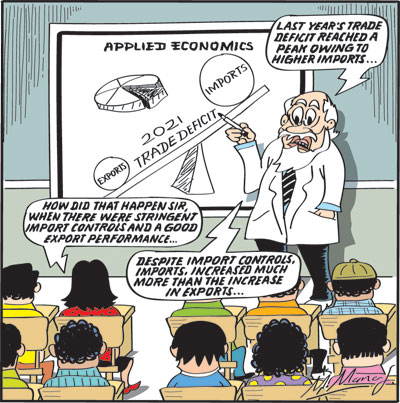Columns
Why the trade deficit widened despite import restrictions and export growth
View(s):Despite severe restrictions on non-essential imports, shortages of essential imported items, and export growth of 27 percent, the trade deficit widened in 2021 owing to the large increase in import expenditure. This rather paradoxical outcome was due to the structure and composition of imports and exports.
Trade deficit
The trade deficit increased to a record US$ 4.6 billion in 2021 in spite of severe import restrictions and increased exports.
Despite restrictions imposed on imports of non-essential imports and difficulties in obtaining foreign exchange for imports, import expenditure increased from US$ 16 billion in 2020 to US$ 20.6 billion in 2021. This increase in imports by 28.5 percent or US$ 4.6 billion was due to increases in consumer goods, intermediate goods and capital goods.
This implies that much of our imports are essential and difficult to contain.
The 2021 trade deficit was the highest in the last three years. The 21 percent import growth outweighed the strong growth in exports of 28.5 percent. Last year’s exports of US$ 15.6 billion were the highest export earnings in the last three years. Yet, the trade deficit expanded owing to higher imports.
 Puzzle
Puzzle
What puzzles most observers of the economy is how the trade deficit ballooned when there were stringent import controls, foreign exchange restrictions and impressive growth in exports. The answer lies in the structure and composition of the country’s imports and exports.
Import dependency
The country has been an important-export economy for centuries. This has been especially so in the modern era. In the first three decades after independence, the country’s exports consisted mainly of primary products, tea rubber and coconut and there was a heavy reliance on all categories of imports: food, consumer durables, raw materials, and capital goods.
Change
Although the country’s import-export structure changed after the liberalisation of the economy in 1977, the economy continues to be an import-dependent one. However, the character of the import dependency has changed.
Industrial exports
Manufactured exports constituted about 75 percent of the country’s exports compared to less than 25 percent of agricultural exports. While the domestic value addition in agricultural exports is about two-thirds, the value addition of manufactured exports is only about 40 percent. This explains why an increase in exports to US$ 15 billion did not make much of a dent in our trade balance.
Raw materials
Intermediate imports consisting of raw materials for industry, fuel and other essentials for industry and the livelihoods of people are a high component of imports. In addition, imports of essential food and other items were high.
Persistent trade deficits
It is this export-import character that has led to persistent trade deficits. There have been only four years of small trade surplus between 1950 and 2021.
Implications
The implications of this analysis are that the trade deficit can be narrowed by only a much higher export growth, including growth in agricultural exports that have not fared well owing to inadequate exportable surpluses.
An import restricting strategy is impractical as most imports are essential for the livelihoods of people, raw materials for industry and agricultural production.
Essential imports
This dependence on essential imports means that international price increases have a huge impact on the country’s import expenditure. This is especially so in respect of fuel import expenditure that rose last year. Fuel imports increased by US$ 1.2 billion to US$ five billion–20 percent of total import expenditure.
Other significant increases in import expenditure were in textiles and textile articles, machinery and equipment, base metals, medical and pharmaceuticals, chemicals and plastics. There were also increases in telecommunication devices, home appliances, food and beverages. These are essential for the country’s economic output and livelihoods.
Recapitulation
Despite import restrictions and foreign currency shortages, imports increased by 28.5 percent or US$ 4.6 billion to US$ 20.6 billion in 2021. This was the highest in the last three years.
The exception was fertiliser imports that decreased by 39 percent to US$ 158 million with disastrous consequences to the economy. Consequently, agricultural exports are likely to decrease and imports of food likely to increase this year.
Conclusion
The Sri Lankan economy will remain an import dependent economy owing to the country’s limited resource base. As has been demonstrated by last year’s trade performance, import controls are not a solution. Much higher exports of goods and services are needed to contain the trade deficit to an amount that will be offset by workers remittances, earnings from tourism and net capital inflows.
Trade and exchange rate policies are vital to improve the external trade and payments performance. Wider economic reforms are needed for a sustainable resolution of the country’s economic woes.
Buying or selling electronics has never been easier with the help of Hitad.lk! We, at Hitad.lk, hear your needs and endeavour to provide you with the perfect listings of electronics; because we have listings for nearly anything! Search for your favourite electronic items for sale on Hitad.lk today!


Leave a Reply
Post Comment